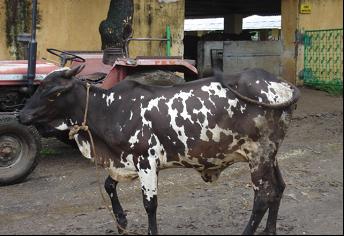Type the name of the breed you're looking for below
[wpdreams_ajaxsearchlite] Don't see the breed your're looking for? Click here and let us know!
Dangi cattle
| Place of Origin | India |
| Origin | Dangis have taken their name from the tract of the country in Bombay State known as Dangs. It is a hilly tract with heavy rainfall and very poor agricultural economy. The breed has become well-known on account of its hardy nature and its ability to work hard under heavy rainfall conditions. The Dangi breed, which is similar to Deoni, appears to fit into the group of cattle represented by the Gir, Red Sindhi and Sahiwal. |
| Purpose | They are a very good draught (working) breed and known for their adaptability to heavy rainfall areas. |
| Appearance | The Dangis are of broken red and white or black and white colour. The animals are medium in size, with deep bodies and generally of ponderous build. The height behind the hump ranges from about 45 to 50 inches while the heart girth measures from about 58 to 60 inches, on the average. The head is usually small with a slightly protruding forehead. The muzzle is large. The animals have powerful hind and forequarters with a short back well-coupled, and the legs are short and stout. The hooves are exceptionally hardy, being black and flint-like. The dewlap is slightly pendulous. The sheath, though loose, is not excessively pendulous. The hump is medium-sized and firm. The skin is of medium thickness and the coat is shiny. It is observed to exude an oily secretion which protects it from heavy rain. |
| Horns | The horns, though of variable size, are generally short and thick. The ears are small. |
| Other Considerations | The Dangis are primarily medium-slow draft animals. They are well-known for their excellent working qualities in heavy rain and in rice fields and also on the hilly tracks. They are hardy animals and subsist mostly on grazing alone. As draft animals they carry heavy timber at the rate of 2 to 3 miles per hour depending upon the type of terrain and can cover a distance of 20 to 24 miles per day. They are poor milkers but attempts have been made to improve their milking qualities. |



